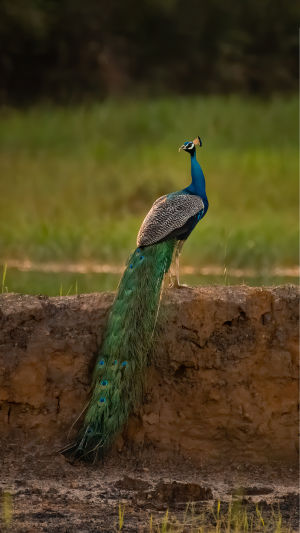The peacock is a very noble symbol in both the ancient East and the West. In Eastern legends, the peacock is the descendant of the phoenix, the head of birds. In Western mythology, the peacock is the holy bird of Hera, because Hera is called Juno in Roman mythology. This article will tell you some facts about peacocks.
When it comes to peacocks, the images of peacocks in zoos always come to mind. But in fact, most of the peacocks in the zoo are blue peacocks or the hybrid offspring of blue peacocks and green peacocks under artificial breeding conditions.
Since 2009, the International Union for Conservation of Nature has upgraded the green peacock from "vulnerable" to "endangered" globally.
Peacocks belong to the order Galliformes, Phasianidae, and the genus Peacock. In other words, this beautiful bird is actually a kind of chicken. There are only two species in the genus Peacock, the blue peacock, and the green peacock.
Blue peacocks are distributed in India and Sri Lanka; green peacocks are distributed in Southeast Asia and the western and southern parts of Yunnan, China, and wild numbers are rare. But one might ask, what's up with the white peacock? In fact, the white peacock is a variation of the blue peacock under artificial breeding.
The peacock is 90 to 130 cm (35 to 50 inches) long and has a 150 cm (60 inches) long tail screen, which is bright metallic green. The tail screen is mainly composed of coverts above the tail, which are extremely long and have an iridescent "eye ring" at the tip surrounded by blue and bronze.
During courtship performances, the male peacock raises his tail under the tail screen. As a result, the tail screen is erected and forward, and when the courtship performance reaches its climax, the tail feathers vibrate, flash, and rattle.
Peacocks don't fly very well because their bodies are a bit heavy and their wings aren't that strong.
Peacocks are famous for their ability to open their screens. The male peacock feathers are emerald green, and the lower back shines with a copper-colored luster. The coverts on the tail are particularly developed, usually tucked behind the back, and stretched about 1 meter long.
These feathers are colorful and slender, like golden-green velvet, and at the ends, there are numerous large eye spots composed of purple, blue, yellow, red, and other colors.
When the peacock opens the screen, the tail reflects the brilliance, like countless small mirrors, it is really bright and dazzling. They have stout bodies, the male bird is about 1.4 meters long, and the female bird is about 1.1 meters long.
The crown of feathers standing tall on the top of the head is also unique. The female peacock has no tail screen, and the back is dark brown and glowing green, but it is not as beautiful as the male peacock.
Wild peacocks mainly live in open woodlands and forest margins, usually below 3,000 meters above sea level, and are not far from water sources. Every evening, peacocks in clusters would fly to high places and spend the night standing on branches about 10 meters from the ground, because it is relatively safe here.
In the early morning, peacocks will vibrate their wings, comb their feathers, and chirp a few times before flying down the branches.
They have two peak feeding periods a day, after getting off the tree in the morning and before getting up in the evening, mainly looking for food such as grass seeds, fruits, and insects. At sunset, the sky is getting dark, and the peacocks will fly back to the high branches to spend the night.
Peacocks are mostly "polygamous", that is, one male leads many females. During the breeding season, the female bird will dig a shallow pit with her feet on the ground of the tall grass, and pad it with weeds and fallen leaves, which is the bird's nest.
Females lay 3 to 8 eggs per clutch, and similar to domestic chickens, females only begin to hatch when a clutch of eggs has been laid, which ensures that the chicks hatch at the same time. Unlike domestic chickens, peacocks have an incubation period of 27 to 30 days instead of 21.





